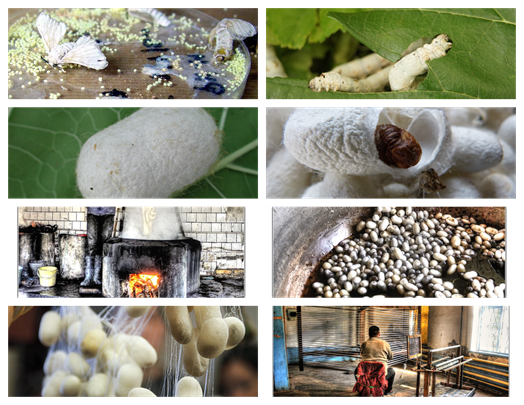PDF chapter test TRY NOW
What is sericulture?
The cultivation and production of silk are known as sericulture.
Production of silk:
During its life cycle, the adult female silk moth lays about 500 eggs. After the laying of eggs, these eggs are placed in cold storage for six weeks.
Then, the eggs are placed in an incubator. The eggs hatch out into larvae after ten days, and the larvae spend the next 35 days eating the mulberry leaves.
These silkworms spend about five days producing silk and spinning their cocoon of a single long thread. Then these cocoons are boiled to easily unwind the silk and kill the pupae inside.
If the silk moths hatch, the long silk fibres will get turned by the hatching of the moth. The cocoons are unwound, and then the individual silk filament is reeled together so that a thread that large enough for weaving is obtained.
Then the silk thread is then cleaned, dyed, and finally woven into fabric.

Sericulture
Characteristic features of silk:
- Silk is a fibre that is very soft, comfortable, and versatile.
- It can be dyed easily.
- It is the strongest natural fibre.
- It has very poor resistance to exposure to sunlight.
- It is an elastic fibre.
- It can retain its shape and have moderate resistance to wrinkling.
- Silk is a protein fibre that is a non-conductor of heat which is similar to that of wool.
- Compared to the other fabrics, as silk is a protein fibre, it has a good absorbency.
Uses of silk:
Silk has a natural fibre known for its natural beauty and elegance. During warm weather, it gives comfort, and during colder climates, it provides warmth.
It is used to manufacture classical and high fashion clothes, modern dresses, particularly silk sarees. It is also used in the production of wall hangings, curtains, rugs, and carpets. It is also used in the production of surgical threads for sutures.
Important!
The world's second-largest silk producing country is India. In Tamil Nadu, Kancheepuram,
Thirubhuvanam, and Arani are famous places for silk production.
Thirubhuvanam, and Arani are famous places for silk production.
Reference:
https://www.flickr.com/photos/danielmennerich/38050576945
https://www.flickr.com/photos/danielmennerich/39948913595
https://www.flickr.com/photos/danielmennerich/39935428301/in/photolist-21jbzvQ-23S9Cdk-25m6nKc-23QXvvg-ZYp9S6-EqfEYc/
flickr.com/photos/danielmennerich/25216015747/in/photolist-21jbzvQ-23S9Cdk-25m6nKc-23QXvvg-ZYp9S6-EqfEYc/
https://www.pxfuel.com/en/free-photo-odtfk/download
https://www.maxpixel.net/Silkworm-Summer-Share-In-Who-In-The-Powder-Mulberry-3576503
https://www.pxfuel.com/en/free-photo-exwlu/download
https://www.pxfuel.com/en/free-photo-oriia/download
https://commons.wikimedia.org/wiki/File:Bombyx_mori_01.jpg
